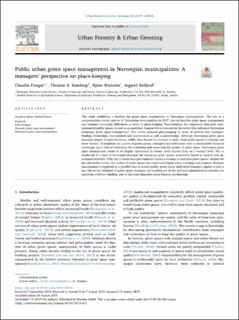Public urban green space management in Norwegian municipalities: A managers? perspective on place-keeping
Peer reviewed, Journal article
Published version
Permanent lenke
https://hdl.handle.net/11250/2670312Utgivelsesdato
2019Metadata
Vis full innførselSamlinger
Originalversjon
10.1016/j.ufug.2019.126438Sammendrag
This study establishes a baseline for green space management in Norwegian municipalities. The aim of a comprehensive survey sent to all Norwegian municipalities in 2017, was to describe green space management and compare municipal differences in terms of place-keeping. Place-keeping, the responsive long-term managementofpublicspaces,isusedasananalyticalframeworktocharacterisethefactorsthatinfluenceNorwegian municipal green space management. The survey assessed place-keeping in terms of policies and strategies, funding, evaluations, management and maintenance as well as partnerships. Although Norwegian green space managers expect budgets to remain stable, they foresee an increase in tasks, more green spaces to manage and more visitors. To maintain the quality of green spaces, managers face difficulties such as incalculable financial challenges and a lack of techniques for evaluating and measuring the quality of green space. Norwegian green space management seems to be largely operational in nature, with limited focus on a tactical level. This is reinforced by a lack of municipal strategies for managing green spaces, potentially based on tactical and operational expertise. Only one in three managers reported having a strategy to maintain green spaces, despite the fact that in the survey, the quality of green spaces was rated more highly when a strategy was in place. Strategic management is suggested as a possible way to ensure quality green space. Individual managers appear to play a key role in the initiation of green space strategies, in reaching out to the political–administrative interface for acquiring sufficient funding, and to facilitate long-term place-keeping partnerships.

